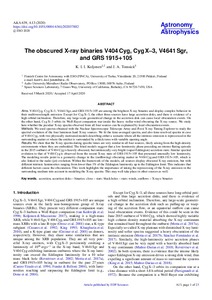The obscured X-ray binaries V404 Cyg, Cyg X-3, V4641 Sgr, and GRS 1915+105
K.I.I. Koljonen; J.A. Tomsick
The obscured X-ray binaries V404 Cyg, Cyg X-3, V4641 Sgr, and GRS 1915+105
K.I.I. Koljonen
J.A. Tomsick
EDP SCIENCES S A
Julkaisun pysyvä osoite on:
https://urn.fi/URN:NBN:fi-fe2021042827271
https://urn.fi/URN:NBN:fi-fe2021042827271
Tiivistelmä
Aims. V404 Cyg, Cyg X-3, V4641 Sgr, and GRS 1915+105 are among the brightest X-ray binaries and display complex behavior in their multiwavelength emission. Except for Cyg X-3, the other three sources have large accretion disks, and there is evidence of a high orbital inclination. Therefore, any large-scale geometrical change in the accretion disk can cause local obscuration events. On the other hand, Cyg X-3 orbits its Wolf-Rayet companion star inside the heavy stellar wind obscuring the X-ray source. We study here whether the peculiar X-ray spectra observed from all four sources can be explained by local obscuration events.Methods. We used spectra obtained with the Nuclear Spectroscopic Telescope Array and Rossi X-ray Timing Explorer to study the spectral evolution of the four luminous hard X-ray sources. We fit the time-averaged spectra, and also time-resolved spectra in case of V404 Cyg, with two physically motivated models describing either a scenario where all the intrinsic emission is reprocessed in the surrounding matter or where the emitter is surrounded by a thick torus with variable opening angle.Results. We show that the X-ray spectra during specific times are very similar in all four sources, likely arising from the high-density environments where they are embedded. The fitted models suggest that a low-luminosity phase preceding an intense flaring episode in the 2015 outburst of V404 Cyg is heavily obscured, but intrinsically very bright (super-Eddington) accretion state. Similar spectral evolution to that of V404 Cyg is observed from the recent X-ray state of GRS 1915+105 that presented unusually low luminosity. The modeling results point to a geometry change in the (outflowing) obscuring matter in V404 Cyg and GRS 1915+105, which is also linked to the radio (jet) evolution. Within the framework of the models, all sources display obscured X-ray emission, but with different intrinsic luminosities ranging from lower than 1% of the Eddington luminosity up to the Eddington limit. This indicates that different factors cause the obscuration. This work highlights the importance of taking the reprocessing of the X-ray emission in the surrounding medium into account in modeling the X-ray spectra. This may well take place in other sources as well.
Kokoelmat
- Rinnakkaistallenteet [27094]
